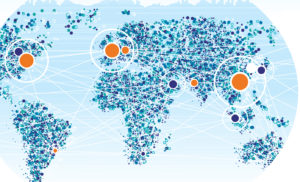 Uncertainty seems to be the word of the day in global sourcing. From shifts in political, economic and trade policies around the world to changing expectations in terms of speed to market, there are numerous powers at play that suppliers, retailers and brands will have to watch closely over the coming months.
Uncertainty seems to be the word of the day in global sourcing. From shifts in political, economic and trade policies around the world to changing expectations in terms of speed to market, there are numerous powers at play that suppliers, retailers and brands will have to watch closely over the coming months.
One of the most talked about factors at play is political uncertainty in the United States as the new administration gears up for some significant change to the status quo. “Executive orders have been passed to eliminate the Trans-Pacific Partnership (TPP) deal and advocated bilateral trade agreements. These changes in trade pacts will significantly influence future strategic sourcing decisions and the supply chains of retailers and brands,” says Asmita Pahwa, Senior Director of Global Sourcing and Supply Chain Management for Daymon.
Proposed changes in the tariff structure could also lead to a major shakeup in sourcing strategies. Commonly called “border adjustment,” the proposed tax would eliminate the incentives businesses currently get for moving or localizing operations outside of U.S. borders. Exports would be exempt from U.S. taxes, but imports would not be deducted as a cost of doing business. On the flip side, if other countries implement protectionist policies, U.S. exports could become subject to heavy foreign taxes. Coupled with the predicted rise in interest rates, Pahwa says that these changes will significantly impact the cost of doing business.
Europe has its own set of woes centered around political and economic uncertainty. There are continuing doubts over the future of the euro and the results of upcoming 2017 elections in France, Holland, Germany—and possibly in Italy, Spain and even the United Kingdom. According to Pahwa, though there will be no quantifiable changes in rules governing sourcing until Britain leaves the European Union—which is likely not to happen before spring 2019—worries about relative exchange rates, widely varying inflation and further collapses of consumer confidence will be a constant background concern throughout the next few years.
A variety of factors in other regions are combining to make global sourcing much more complex and uncertain, including:
- Geopolitical risks in Turkey and Ethiopia.
- Security concerns in Pakistan, Bangladesh and Turkey.
- Volatile currencies in countries such as Brazil, Mexico and Turkey.
- Increasing corporate social responsibility demands.
- Pressure to increase speed to market, while also lowering costs.
Under pressure from nearly every direction, it’s fair to say that supply chain network models will undergo continuous analysis and scrutiny in the coming year. According to Pahwa, Daymon is already assessing various landed cost scenarios and tax factors within a product lifecycle to ascertain potential threats to profitability. Daymon’s teams have also begun to analyze and educate the business on other potential impacts to existing business.
“If one thing is certain in 2017, it’s that there will be changes in how we source,” says Pahwa. “Creative and innovative product sourcing will be an important differentiator and competency throughout 2017, as consumers continue to drive the demand for customization and innovation. At Daymon, we are focused on proactively addressing these issues to help our partners prepare for the future.”
To learn more about Daymon global sourcing solutions, contact Asmita Pahwa, Senior Director, Global Sourcing and Supply Chain Operations at apahwa@daymon.com.

